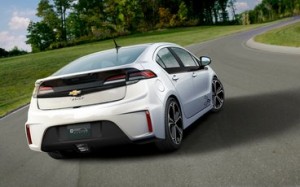 General Motors Corp. has been championing the next-generation 2016 Chevrolet Volt that’s scheduled to debut at the Detroit auto show in January. “You’ll see improvements all the way across, from technology to design,” Tim Mahoney, GM’s chief marketing officer for Global Chevrolet, told reporters last week. “Detroit seems like the right place to do that.”
General Motors Corp. has been championing the next-generation 2016 Chevrolet Volt that’s scheduled to debut at the Detroit auto show in January. “You’ll see improvements all the way across, from technology to design,” Tim Mahoney, GM’s chief marketing officer for Global Chevrolet, told reporters last week. “Detroit seems like the right place to do that.”
GM is holding back on information – it will be “good value,” but no details have been released on what it will cost, if the battery pack can deliver longer range than its current 38 miles, and what these technology and design improvement will look like. Automotive News reported that it will have a third seat in the rear and will feature a downsized, 1.0L, three-cylinder engine compared to its current 1.4L, four-cylinder engine.
If I were present at the Management Briefing Seminar in Traverse City, Mich., I may have mustered the courage to ask Mahoney two questions:
- How many Volts does GM plan to build and deliver this year and next?
- How committed is GM and Chevrolet to marketing the Volt through corporate advertising and supporting and encouraging its dealer network?
Mahoney also said that GM considers the Volt “not a mass-market” vehicle any longer. I would ask another question: When has it ever been one? When the plug-in hybrid was introduced in late 2010, former GM CEO Dan Akerson thought the automaker would produce 60,000 Volts in 2012. The reality has been that GM has only built and sold about 65,000 units in nearly four years.
GM has been proud to build the best-selling plug-in hybrid in the US, but it potentially could have been much higher in sales volume. It was competing neck-to-neck with the Nissan Leaf, but the Leaf left the Volt in the dust several months ago.
To my colleagues at GM and Chevrolet, here are a few points to consider:
- You have passionate, loyal fans out there – many of them Volt owners and some of them looking forward to owning their first. Mahoney mentioned that GM plans on doing it, including on social media. What about on TV commercials during sporting events? Ride and drives and event sponsorships also make much sense. The Chevrolet brand is popular with many Americans, and experiential testimony from Volt users could be a tipping point for car shoppers.
- If you’re able to extend the range on a charge, why not get on the stump and hawk that point? Volt drivers many times have been amazed how many miles they’ve traveled on battery only and what the actual extended range could be if driven correctly. Their testimonials would help, and emphasizing that benefit in ads would do so, too.
- Consider building more of them and getting them out to more dealer lots around the country. Like other EVs, sales have been heavy in just a few markets. There is interest in other markets, though it would need more advertising and showing the product. That’s where the Chevrolet brand image would come in handy – GM considers the Volt to be a “halo” in its Chevrolet marketing and that could be exploited much more. If the price is coming down, and with incentives for buyers and good leasing deals, that would help. As for production, GM has been happy enough to see cost-saving results in Volt assembly at its Hamtramck plant that it decided to invest $121 million more there late last year. You’ve got best practices in place – why not assemble and deliver more Volts?
- Promote the EV charger options owners have. Last year, Bosch unveiled a new $450 Level 2 charger, which is the preferred charger for the Volt. It’s cheaper and simpler to set up and use than other chargers have been. That’s a key stumbling block for car shoppers. They’d be impressed if the charging station were more affordable; and if dealers could get them assistance on having the charging stations installed at their homes.
- Show off the technology. GM’s Voltec powertrain has been strong enough to move beyond the Volt to the Cadillac ELR. Volt owners are finding that the Volt’s electronic and cooling systems are working well – they’re experiencing lack of range degradation. It also helps that the Volt emerged from its NHTSA-investigated lithium-ion battery fires a few years ago, while Tesla Motors still faces questions about the fire-proof safety of its li-ion battery pack.
- Speaking of safety, the Insurance Institute for Highway Safety gave the 2014 Volt a Top Safety+ rating. That followed a crash test on a dozen small cars including the Volt along with the Nissan Juke, Mini Cooper Countryman, and the Ford C-Max Hybrid; the Volt was the only model to receive the institute’s coveted safety rating.




Good info and questions asked here Jon. I was thinking that no one was willing to ask the tough ones. Why on earth would the Volt be designed with such a shortsighted range? Originally it was claimed that battery technology was not capable but Tesla proved that is most certainly was and that was years ago. SO yes, I believe GM is holding back. The real question is why?